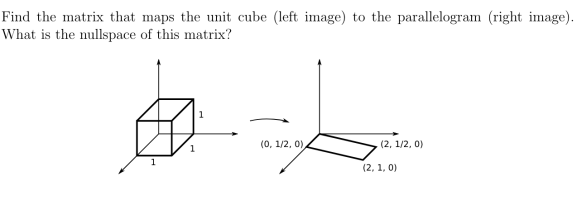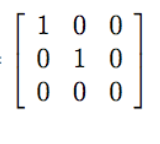
Hi all, I'm struggling quite a lot with this problem. I can find the null space of a matrix, but I don't know where to start with finding the matrix that transforms the object on the left to the object on the right. From what I think, the unit cube (in R3) was mapped to the x-y plane (in R3) as z=0 for all the coordinates of the parallelogram.
The transformation matrix that maps/projects objects to the x-y plane is:
 but I think that the 1s in the matrix would be a & b (variables). Since the vertices aren't labeled, I'm finding it difficult to know which specific points of the unit cube correspond to specific points in the parallelogram. I tried having a=2 and b= 1/2 in the x-y projection matrix but it doesn't work for all points. I was wondering if anyone has suggestions on how I could approach this problem : )
but I think that the 1s in the matrix would be a & b (variables). Since the vertices aren't labeled, I'm finding it difficult to know which specific points of the unit cube correspond to specific points in the parallelogram. I tried having a=2 and b= 1/2 in the x-y projection matrix but it doesn't work for all points. I was wondering if anyone has suggestions on how I could approach this problem : )
Last edited:
